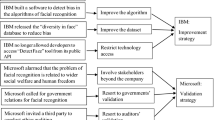Abstract
Can machine vision step beyond the ocularcentric metaphysics of the Western gaze and the reproduction of racial capital? Paul Virilio argued that machine vision requires no perceptual response or recognition of the world. The computer’s series of coded impulses mediate the real autonomously from physical and energetic analogies. This article calls “negative optics” this inhuman mode of machine vision that withdraws from the ocularcentric rules of transparency. Not only negative optics offers an internal critique of ocular metaphysics, but it also defies the equation of value between 0 and 1 s that sustains the universal law of capital. The equation of value needs the nullification of the racialized and gendered body to meet the function of surrogate machines feeding the neo-liberal human subject. Here, however, the negative optics of machine vision withdraws matter from the equation insofar as the AI mismatches of concepts and objects requires the formation of socio-technical assemblages amongst surrogates of all kinds. The intricacies of this surrogacy are discussed in connection to artist Elisa Giardina’s video installation entitled, The Cleaning of Emotional Data (2019). This video presents the background to address a surrogate human–machine alliance that steps beyond the human–machine equation of value. By starting from the negativity of the image, the racialized and gendered conditions of techno-social labor under artificial intelligence capitalism show that the equation of value maintains the condition of the zero of blackness, which like matter without form, has no value (On matter beyond the equation of value 2017). Drawing on François Laruelle, the article continues to elaborate the possibilities of a material image without form in terms of what Laruelle calls, the “fractal algorithm of the photo”. The article concludes that the negative optics of machine vision stands for the alien origination of knowledge, values, materialities that overturn the equation of value through the fractal infinities of 0 s.
Similar content being viewed by others
Notes
According to Lisa Lowe, the concept of “racial capitalism” developed by Cedric Robinson, implies that capitalism expands not through rendering all labor, resources, and markets across the world identical, but by precisely seizing upon colonial divisions, identifying particular regions for production and others for neglect, certain populations for exploitation and still others for disposal (Lowe 2015, p 149).
Amazon’s Mechanical Turk, as well as CrowdFlower, Clickworker, Toluna, and others, are largely unregulated websites that allow businesses and individuals to post short tasks that are also called Human Intelligent Tasks assignments and pay workers—in cash or, sometimes, gift cards—to complete them. In particular, Amazon set up the website Mechanical Turk in 2005 for humans to perform tasks that are hard for computers. Amazon executive Jeff Bezos has called this kind of human task, “artificial artificial intelligence.” This means that when a task is easier for a human than a computer, the computer calls a human. It is this double artificiality with which underpaid humans are identified that will be interesting to explore in this new condition of extraction of value. Amongst the most common tasks are the recording of information appearing in an image and the transcription of audio and video files. See https://www.pewresearch.org/internet/2016/07/11/what-is-mechanical-turk/ (last accessed June 20th, 2020).
The authors draw on black feminist, Hortense Spillers, to discuss the surrogate human effect at a constitutive part of the grammar of colonialism and technoliberalism. I take these critical reflections about how the racialized other as much as the machine have surrogate status in colonial technocapitalism as central to the arguments about the racialized socio-technical assemblage at play within contemporary images of AI and automation. See Hortense Spillers, “Mama’s Baby, Papa’s Maybe: An American Grammar Book.” Diacritics 17 (1987),p 67.
“Apophenia” (/æpoʊˈfiːniə/) is the tendency to mistakenly perceive connections and meaning between unrelated things. The term (German: Apophänie) was coined by psychiatrist Klaus Conrad in his 1958 publication on the beginning stages of schizophrenia.
References
Atanasoski N, Vora K (2019) Surrogate humanity. Race, Robots and technological futures (perverse modernities: a series edited by Jack Halberstam and Lisa Lowe). Duke University Press, Durham and London
Ferreira da Silva D (2017) “1 (life) ÷ 0 (blackness) = ∞ − ∞ or ∞ / ∞: On Matter Beyond the Equation of Value.” e-flux 79, February. https://www.e-flux.com/journal/79/94686/1-life-0-blackness-or-on-matter-beyond-the-equation-of-value/
Galloway AR (2014) Laruelle: against the digital. University of Minnesota Press, Minneapolis
Giardina E (2019) The cleaning of emotional data. Aksioma—Institute for Contemporary Art, Ljubljana. https://aksioma.org/cleaning.emotional.data/
Hinton G et al (2017) Dynamic routing between capsule. In: 31st conference on neural information processing systems, NIPS 2017, Long Beach, CA. https://arxiv.org/abs/1710.09829. Accessed 22 Apr 2020
Laruelle F (2010) The concept of non-photography. Urbanomic, Falmouth
Laruelle F (2013) The transcendental computer: a non-philosophical utopia. Trans. Taylor Adkins and Chris Eby, Speculative Heresy, August 26. https://speculativeheresy.wordpress.com/2013/08/26/translation-of-laruelles-the-transcendentalcomputer-a-non-philosophical-utopia/.
Lowe L (2015) The intimacies of four continents. Duke University Press, Durham, NC
Paglen T (2014) The operational image, e-flux. November. https://www.e-flux.com/journal/59/61130/operational-images/
Paglen T (2016) Invisible images (your pictures are looking at you). The new enquiry. December. https://thenewinquiry.com/invisible-images-your-pictures-are-looking-at-you/
Steyerl H (2015) A sea of data: apophenia and pattern (mis-)recognition. e-flux. April. https://www.e-flux.com/journal/72/60480/a-sea-of-data-apophenia-and-pattern-mis-recognition/
Virilio P (1994) The vision machine. Indiana University Press, Bloomington, IN
Author information
Authors and Affiliations
Corresponding author
Ethics declarations
Conflict of interest
Nothing to declare.
Additional information
Publisher's Note
Springer Nature remains neutral with regard to jurisdictional claims in published maps and institutional affiliations.
Rights and permissions
About this article
Cite this article
Parisi, L. Negative optics in vision machines. AI & Soc 36, 1281–1293 (2021). https://doi.org/10.1007/s00146-020-01096-7
Received:
Accepted:
Published:
Issue Date:
DOI: https://doi.org/10.1007/s00146-020-01096-7




